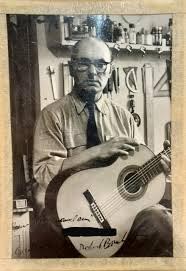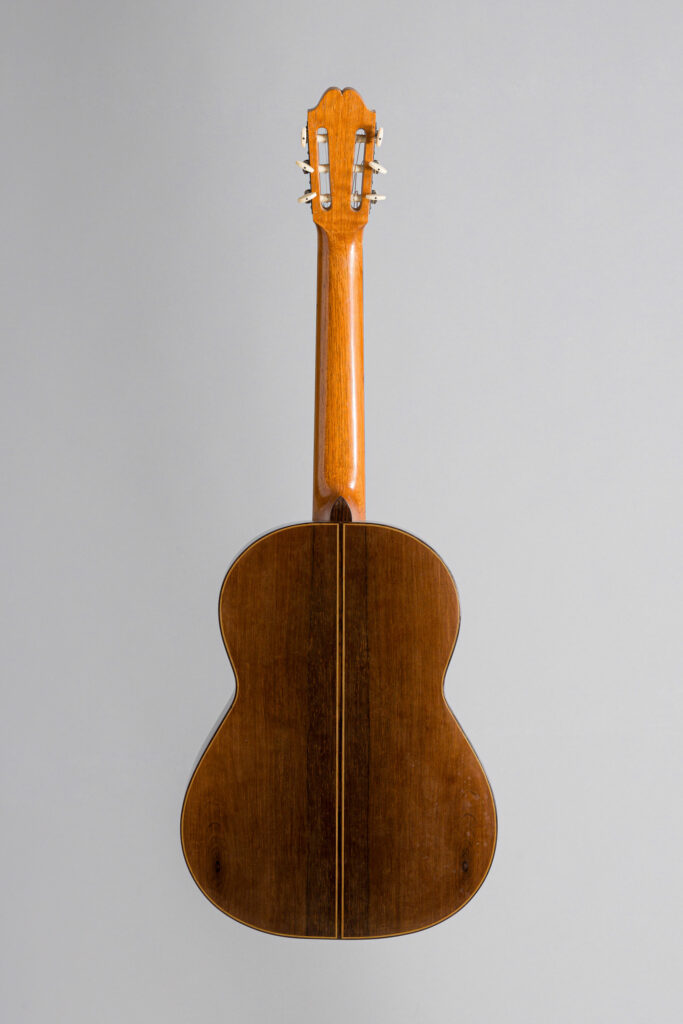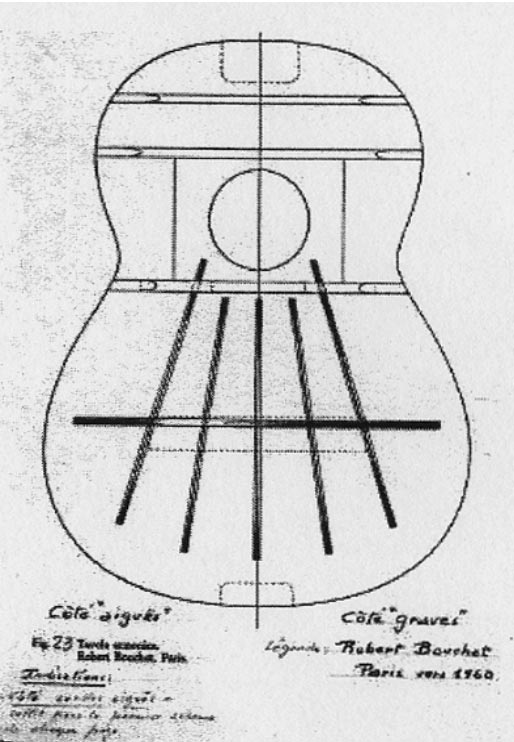Le 15 novembre prochain, une rare guitare de Robert Bouchet sera présentée à la vente à Vichy Enchères. Fabriquée en 1958, elle appartient à la deuxième époque du luthier, celle que les spécialistes qualifient de période de la maturité, marquée par des choix esthétiques affirmés et des évolutions constructives décisives. Cette guitare porte l’étiquette et la marque au fer du luthier et reflète le soin particulier que Bouchet réservait à ses meilleurs instruments.

Robert Bouchet occupe une place singulière dans l’histoire de la guitare du XXe siècle. Peintre de formation, luthier autodidacte, il a redéfini la facture française à partir des années 1950. Professeur de dessin installé à la Cité Montmartre aux Artistes, il découvre la guitare par curiosité, avant de se lancer, en 1946, dans la fabrication de son premier instrument. Les musiciens seront tout de suite séduits par cette guitare, mêlant talent, finesse, qualité des matériaux et sobriété ornementale.
Au fil des années, Bouchet développe une facture personnelle, nourrie par l’observation des guitares de Torres. Sa production, volontairement limitée – moins de six guitares par an – s’adresse à une poignée de musiciens et de collectionneurs.
Retrouvez plus d’informations sur la biographie de Bouchet en consultant notre article :


L’instrument présenté à la vente Vichy Enchères du 15 novembre 2025 a été réalisé à Paris en 1958. Il s’agit d’un modèle construit au moment où Bouchet entre dans ce que l’on nomme aujourd’hui sa seconde période – celle de la maturité. À partir de 1957, le luthier modifie en profondeur sa structure de table d’harmonie. Il abandonne le barrage à sept brins de type Torres, pour un barrage en éventail à cinq brins, auquel il ajoute une innovation majeure : une barre d’âme, placée sous le chevalet, perpendiculaire au fil de bois, pensée pour renforcer la stabilité de la table et affiner l’acoustique de l’instrument.
Ce système permet de renforcer la zone des aigus sans alourdir la table – on obtient alors une sonorité plus équilibrée, un sustain plus long, des attaques plus franches. Ces qualités, très recherchées par les interprètes, ont contribué au succès des guitares Bouchet auprès des plus grands noms, tels que Julian Bream, Alexandre Lagoya et Ida Presti, qui enregistrèrent avec des instruments très proches de celui ici présenté.
Comme toujours chez Bouchet, la construction répond à des choix réfléchis : son bois réputé pour ses qualités intrinsèques et sa beauté sombre, une tête au dessin épuré, une rosace finement décorée, le tout magnifié par un vernis léger.
L’instrument est vendu avec son étui d’origine et présente de légères traces d’usage – autant de signes d’une vie musicale bien remplie. Comme toutes les guitares de Bouchet, elle offre le témoignage d’un long travail de recherches, où chaque détail est pensé et annoté dans ses célèbres cahiers d’atelier, aujourd’hui conservés au Musée de la Musique.




Bouchet utilisait le montage espagnol, il travaillait sur un plateau d’assemblage qu’il avait conçu lui-même, avec des voûtes distinctes pour la table et le fond. Il chauffait et striait les surfaces avant collage, utilisait un mélange de colle d’os et de colle de nerf, préparait ses propres outils, y compris une scie circulaire miniature fabriquée pour les filets.
Il collait le chevalet avant de vernir, une démarche inhabituelle mais révélatrice de sa méthode entièrement tournée vers la qualité finale du son.
En refusant toute ornementation superflue, Bouchet a créé un style reconnaissable entre tous, une guitare aux lignes pures, aux proportions justes, au dessin maîtrisé.



Témoignage rare du travail de Robert Bouchet à l’aube de sa pleine maturité, cette guitare de 1958 incarne tout ce qui fait la singularité de son œuvre – une facture précise, une esthétique sobre, une quête constante d’équilibre entre structure et sonorité. Elle s’adresse autant au collectionneur averti qu’au musicien exigeant, soucieux d’entrer en résonance avec l’un des sommets de la lutherie française du XXe siècle.
On 15 November, a rare guitar by Robert Bouchet will be auctioned at Vichy Enchères. It was made in 1958, during the maker’s second period, considered his mature period by experts, and is characterized by bold aesthetics and key structural developments. This guitar bears the maker’s label and brand, and demonstrates the level of care and attention given by Bouchet to his finest instruments.

Robert Bouchet occupies a unique place in the history of the 20th-century guitar making. He was a trained artist and a self-taught maker who changed the course of French guitar making from the beginning in the 1950s. He started out as an art teacher at the Cité Montmartre aux Artistes. A chance encounter led him to take an interest in the guitar, and he went on to make his first instrument in 1946. Musicians were immediately drawn to this guitar, which demonstrated a natural talent, featuring fine craftsmanship, quality materials and sobriety in appearance.
Over the years, Bouchet developed a personal style, informed by his observation of Torres’s guitars. His output, which remained deliberately small – he made fewer than six guitars a year – was destined to a handful of musicians and collectors.
You can find more information regarding Bouchet’s biography in our article:


The instrument presented at the Vichy Enchères sale on 15 November 2025, was made in Paris in 1958. It was made at a time when Bouchet was entering what is now referred to as his second, mature, period. From 1957, the maker made major changes to the construction of his fronts. He abandoned the seven-strand, Torres-style, bracing in favour of a five-strand fan bracing, to which he added a major innovation: a soundpost bar, placed under the bridge, perpendicular to the grain, designed to strengthen the front and improve the sound of the instrument.
This system reinforced the treble range without adding weight to the front, resulting in a more balanced sound, longer sustain, and clearer note production. These qualities, which are highly sought after by musicians, contributed to the success of Bouchet guitars with some of the greatest names in music, including Julian Bream, Alexandre Lagoya and Ida Presti, all of whom recorded with instruments very similar to the one presented here.
As is customary with Bouchet, the construction of this instrument is the result thoughtful decisions, as reflected in the choice of wood, renowned for its intrinsic qualities and dark beauty, the purity of the headstock design, or the finely decorated rose, which are all enhanced by a light varnish.
The instrument is sold with its original case and shows light signs of use – signs of a musical life lived to the full. As with all Bouchet guitars, it attests to extensive research by its maker, where every detail was carefully considered and noted down in his famous workshop notebooks, now preserved at the Musée de la Musique.




Bouchet followed the Spanish construction method, using an assembly board of his own design, with different arches for the front and back. He heated and scored the surfaces before gluing, using a mixture of bone and sinew glue, and he made his own tools, including a miniature circular saw designed for the purfling.
He glued the bridge before varnishing, which is unusual, and denotes the focus of his methodology on producing the best possible sound quality for the finished instrument.
By rejecting all superfluous ornamentation, Bouchet created a style that is instantly recognizable: a guitar with pure lines, precise proportions, and a masterful design.



This 1958 guitar by Robert Bouchet, which is a rare example of the maker’s work dating from the beginning of his mature period, embodies everything that makes his work so unique: meticulous craftsmanship, sober aesthetics and a constant search for balance between structure and sound. It will appeal to both discerning collectors and demanding musicians, looking to experience playing one of greatest instruments produced by 20th-century French guitar making